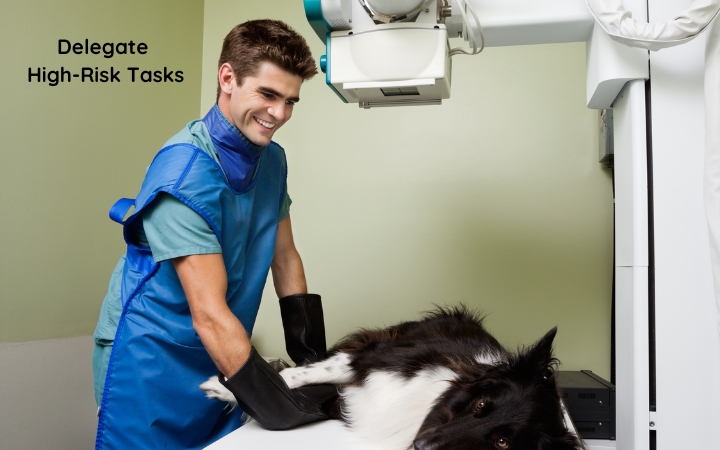Radiation exposure is a significant concern for pregnant veterinary professionals, especially during radiographic procedures. Understanding the risks and implementing effective protective measures is essential for the health of both the mother and the developing fetus.
Understanding Radiation Risks
Exposure to ionizing radiation can have harmful effects on a developing fetus, potentially causing developmental issues and increasing the risk of cancer. Thus, minimizing exposure during pregnancy is paramount. The sensitivity of a fetus to radiation varies depending on the stage of development, with early pregnancy being the most critical period. It’s important to understand that even low levels of radiation exposure can accumulate over time, making it essential to limit exposure as much as possible.
Utilize Protective Gear
Lead aprons, thyroid shields, and lead goggles are essential PPE that can significantly reduce radiation exposure. These should be worn consistently during any radiographic procedures. The use of protective gear should be a standard practice, not just for pregnant workers but for all staff to minimize risks. In addition to wearing PPE, it’s crucial to ensure that these protective items are in good condition and replaced as needed to maintain their effectiveness.
Monitor Radiation Levels
Dosimeters are devices that measure radiation exposure levels. Pregnant workers should wear dosimeters to monitor their exposure regularly. Keeping radiation exposure within safe limits as recommended by health authorities is crucial. Regularly reviewing dosimeter readings can help ensure that exposure levels remain safe. Employers should provide access to dosimeters and ensure that staff are trained on how to use them correctly.
Delegate High-Risk Tasks
Whenever possible, pregnant veterinary professionals should delegate radiographic tasks to non-pregnant colleagues. If this is not feasible, using remote imaging techniques or standing behind protective barriers can reduce exposure. Delegating high-risk tasks helps minimize direct exposure and reduces overall risk. It’s important for colleagues to understand and support these adjustments to create a safer working environment.
Ensure Proper Equipment Maintenance
Regular maintenance and inspection of radiographic equipment are vital. Ensuring there are no leaks and that all safety protocols are followed can help minimize unnecessary exposure. Proper calibration and functioning of the equipment are essential to ensure safety and effectiveness. Scheduled maintenance checks should be a routine part of the clinic’s operations to prevent any unexpected equipment failures.
Follow Safety Protocols Rigorously
Strict adherence to safety protocols, including proper positioning and timing of radiographic exposures, can further reduce risks. Training and regular refreshers on these protocols can be beneficial for all staff members. Ensuring that everyone is well-informed and vigilant about safety practices is critical. Staff should be encouraged to speak up if they notice any deviations from established safety procedures.
Educate and Train Staff
Continuous education and training on radiation safety are essential. All staff members should be aware of the risks associated with radiation and the importance of following safety protocols. Regular workshops and training sessions can reinforce these practices and keep everyone informed about the latest safety guidelines. Providing access to up-to-date resources and training materials can help maintain a high standard of safety.
Implement Safety Audits
Conducting regular safety audits can help identify potential hazards and ensure compliance with safety standards. These audits should review equipment maintenance, PPE usage, and adherence to safety protocols. Addressing any identified issues promptly can help maintain a safe working environment. Safety audits should be comprehensive and involve input from all staff members to ensure that all potential risks are addressed.
Utilize Shielding Techniques
Using shielding techniques such as collimation (limiting the x-ray beam to the area of interest) can reduce radiation exposure. Proper shielding of the radiographic room and ensuring that staff members stay behind protective barriers during exposures are also important. Incorporating shielding into the design of radiographic rooms can provide an additional layer of protection for staff.
Communicate with Healthcare Providers
Pregnant veterinary professionals should maintain open communication with their healthcare providers about their work environment and potential exposure risks. Healthcare providers can offer specific advice and recommendations based on the individual’s health and pregnancy progress. Regular check-ups can help monitor the health of both the mother and the developing fetus.
By taking these precautions, pregnant veterinary professionals can significantly mitigate the risks associated with radiation exposure. Ensuring a safe work environment requires vigilance, adherence to safety protocols, and proactive measures to minimize risks. With proper planning and precautions, pregnant veterinary workers can continue to perform their duties safely.

